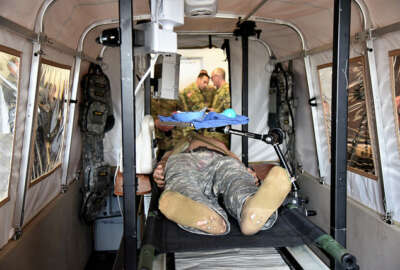

The Army wants to keep its Medical Research and Materiel Command, despite a 2019 law taking it away.
The Army says it will continue working with Congress to hold on to some of the medical infrastructure the Defense Health Agency is supposed to assume control of by 2022.
The Army wants to maintain control of medical research institutions that are of specific importance to the service while also divesting medical infrastructure that is not Army-focused, said Bruce Jette, assistant secretary of the Army for acquisition, logistics and technology.
The 2019 defense authorization act requires the Army hand over its Medical Research and Materiel Command and merge it into the Defense Health Agency.
The Army’s newest argument for clinging to its medical arm is that it needs to keep some of its medical research to protect itself and the nation from obscure diseases that pop up in remote corners of the world where the service is active.

Jette said “orphan diseases” like Ebola are not issues that will give the private drug companies or the National Institutes of Health fame or fortune, but research on them is critical to Army readiness.
“We go where those things are,” Jette said. “Why does the Army end up doing disease research? Because we go where there are some really weird little diseases.”
Army Secretary Mark Esper has already made clear that he is uncomfortable giving up the Army’s medical research command.
“My concern with that provision is it might not enable us to do what we need to do with readiness on the battlefield and training,” Esper said in September. “My preference would be to keep that, because I want to be thinking about what I need on the future battlefield. It’s a readiness issue for me.”
Jette said he has not heard any response from Congress on the potential for more flexibility.
The law states that by Sept. 30, 2022, DHA will establish a leader for Defense Health Agency Research and Development, which will be comprised of Army Medical Research and Materiel Command and other medical research organizations and activities in the armed forces.
The DHA R&D office will be in charge of coordinating defense health program research, development, test and evaluation. A second subordinate organization called DHA Public Health will take over Army Public Health Command, Navy-Marine Corps Public Health Command, Air Force public health programs and any other related defense health activities.
The law also asks for a report on the feasibility of establishing a DHA Education and Training directorate, which would operate under DHA Public Health. DHA Education and Training would be led by the president of the Uniformed Services University of Health Sciences.
Congress also wants a report on the creation of a Defense Health Command, which would supersede DHA.
The 2019 NDAA report language justifies the consolidations as a “centralized organizational framework for the military health system that more clearly focuses the entire system on: Improving total force readiness; meeting the actual medical requirements of combatant commanders; improving proficiency training for military medical providers in a fully integrated, joint training environment; and ensuring greater efficiencies in the delivery of healthcare services, while providing high quality, safe medical care and improving the experience of care for all beneficiaries.”
Copyright © 2024 Federal News Network. All rights reserved. This website is not intended for users located within the European Economic Area.
Scott Maucione is a defense reporter for Federal News Network and reports on human capital, workforce and the Defense Department at-large.
Follow @smaucioneWFED
